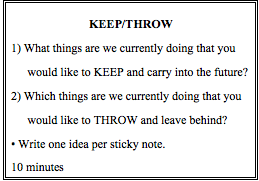“Our group is planning for the future. We know we need to change, but some of the things we are doing are good and shouldn’t be changed. Is there a technique for helping us get rid of the bad and keep the good?”
#14 Keep/Throw
What is Keep/Throw?
Keep/Throw provides a process for a group to agree on what is working and should continue to be done, and what is not working and should be discontinued or changed.
When planning for the future, radical changes are sometimes needed to meet the new goals. In this situation, some people and groups will want to throw everything away and start from scratch. This method definitely gets rid of the bad, but it doesn’t honor or preserve what is already good. It can also leave participants feeling that everything they have done in the past was worthless.
Keep/Throw allows for a healthier, more productive approach to change that supports past successes by honoring what is good.
When to Use Keep/Throw
- When your group is planning for the future
- When your group wants to identify methods to work together more effectively
- When your group is finished with one project and beginning another
NOTE: This technique is often used as a final step to Prouds and Sorries. See my last blog for details.
How to Use Keep/Throw
Before the Meeting
1. Assemble the necessary materials: enough sticky notes, marking pens, and chart paper to bring to the meeting.
2. Create the charts you will use.
During the Meeting
1. Introduce the technique. You might say, for example, “Some of what we have done in the past definitely needs to be changed. But some of what we have done has been very effective and we should keep these things. Let’s use a technique called Keep/Throw to help us differentiate between the two as a first step towards planning how to work together in the future.”
2. Ask the group to individually brainstorm answers to the following two questions on sticky notes, one answer per sticky note. “What things are we currently doing that you would like to Keep and carry into the future?” “What things are we currently doing that you would like to Throw and leave behind?” Post a chart or overhead similar to the one below to support you.
3. Ask the group to bring their ideas forward and attach them to the charts you have pre-labeled Keep and Throw.
4. Ask the group to cluster their ideas with other similar ideas. Split the group in two, one to cluster Keeps and one to cluster Throws. Allow about 10-15 minutes for clustering. Ask the two groups to give each cluster a heading.
5. After each group is finished, ask them to review the work of the other group. When participants have read all the clusters in both the Keep and Throw categories, ask them to sit back down.
6. Debrief the exercise with these or similar questions: “What stands out in your mind as you read this Keep/Throw information?” “What conclusions can we draw?” “What should we do with this information?”
7. Incorporate the information as the group suggests based on their response to the final question, “What shall we do with this information?” For example, you might want to keep the lists as a reference when the group creates goals and action plans for the future.
In Summary:
Keep/Throw is a technique that provides a process for getting participants to consciously think about what they do that works and what doesn’t work. It leads them to make choices about their behavior and work processes as they plan for the future.
Before the Meeting
1. Assemble sticky notes, marking pens, and chart paper.
2. Create the charts you will use.
During the Meeting
1. Introduce the exercise.
2. Ask the group to brainstorm answers to the questions, “What things are we currently doing that you would like to Keep and carry into the future?” “What things are we currently doing that you would like to Throw and leave behind?”
3. Ask the group to bring their ideas forward and place on the appropriate charts labeled Keep or Throw.
4. Split the group in two and ask them to cluster their ideas with similar ideas, one group for Keep and one group for Throw.
5. Ask them to read the work of the other group.
6. Debrief the exercise.
7. Incorporate the information as the group suggests.
Source:
Marvin Weisbord, Discovering Common Ground, San Francisco: Berrett-Koehler Publishers, 1992.
———————-
NOTE: If you would like to receive e-mail notification when I post additional techniques, please sign up through this link. http://eepurl.com/KILan You may unsubscribe at any time.
